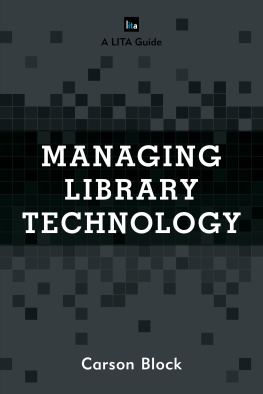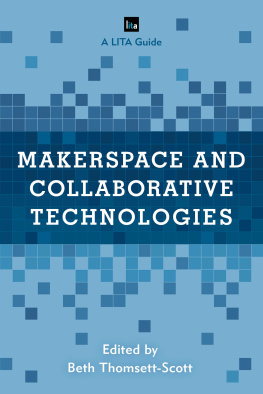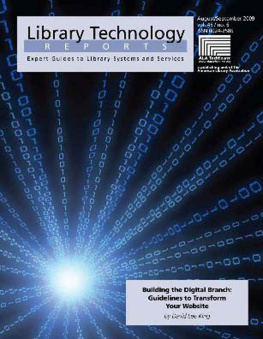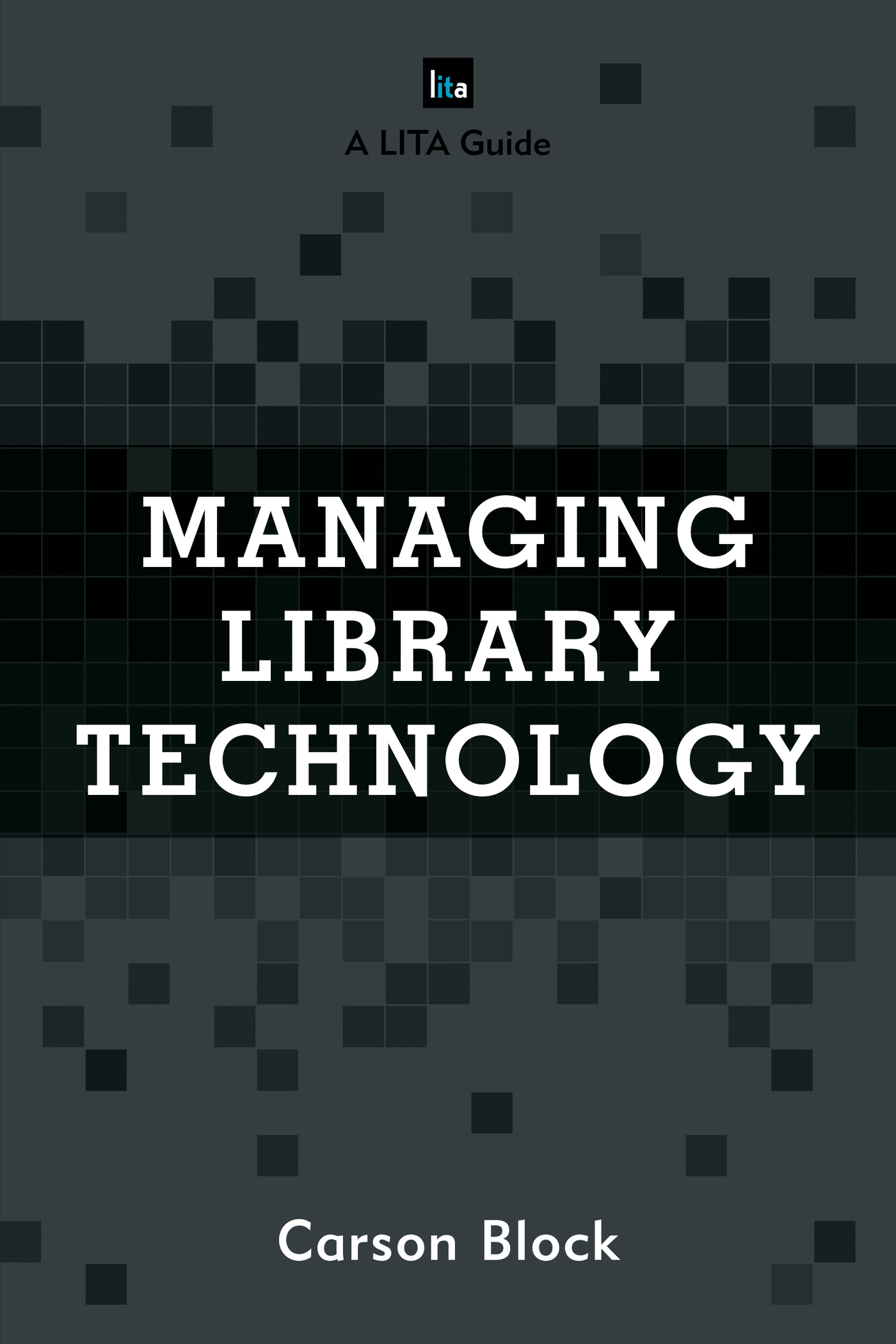Managing Library Technology
LIBRARY INFORMATION TECHNOLOGY
ASSOCIATION (LITA) GUIDES
Marta Mestrovic Deyrup, Ph.D.
Acquisitions Editor, Library Information and Technology Association,
a division of the American Library Association
The Library Information Technology Association (LITA) Guides provide information and guidance on topics related to cutting-edge technology for library and IT specialists.
Written by top professionals in the field of technology, the guides are sought after by librarians wishing to learn a new skill or to become current in todays best practices.
Each book in the series has been overseen editorially since conception by LITA and reviewed by LITA members with special expertise in the specialty area of the book.
Established in 1966, the Library and Information Technology Association (LITA) is the division of the American Library Association (ALA) that provides its members and the library and information science community as a whole with a forum for discussion, an environment for learning, and a program for actions on the design, development, and implementation of automated and technological systems in the library and information science field.
Approximately 25 LITA Guides were published by Neal-Schuman and ALA between 2007 and 2015. Rowman & Littlefield took over publication of the series beginning in late 2015. Books in the series published by Rowman & Littlefield are:
Digitizing Flat Media: Principles and Practices
The Librarians Introduction to Programming Languages
Library Service Design: A LITA Guide to Holistic Assessment, Insight, and Improvement
Data Visualization: A Guide to Visual Storytelling for Librarians
Mobile Technologies in Libraries: A LITA Guide
Innovative LibGuides Applications
Integrating LibGuides into Library Websites
Protecting Patron Privacy: A LITA Guide
The LITA Leadership Guide: The Librarian as Entrepreneur, Leader, and Technologist
Using Social Media to Build Library Communities: A LITA Guide
Managing Library Technology: A LITA Guide
Managing Library Technology
A LITA Guide
Carson Block
ROWMAN & LITTLEFIELD
Lanham Boulder New York London
Published by Rowman & Littlefield
A wholly owned subsidiary of The Rowman & Littlefield Publishing Group, Inc.
4501 Forbes Boulevard, Suite 200, Lanham, Maryland 20706
www.rowman.com
Unit A, Whitacre Mews, 26-34 Stannary Street, London SE11 4AB
Copyright 2017 by American Library Association
All rights reserved. No part of this book may be reproduced in any form or by any electronic or mechanical means, including information storage and retrieval systems, without written permission from the publisher, except by a reviewer who may quote passages in a review.
British Library Cataloguing in Publication Information Available
Library of Congress Cataloging-in-Publication Data Available
ISBN 9781442271807 (hardback : alk. paper) | ISBN 9781442271814 (pbk. : alk. paper) | ISBN 9781442271821 (ebook)
 TM The paper used in this publication meets the minimum requirements of American National Standard for Information Sciences Permanence of Paper for Printed Library Materials, ANSI/NISO Z39.48-1992.
TM The paper used in this publication meets the minimum requirements of American National Standard for Information Sciences Permanence of Paper for Printed Library Materials, ANSI/NISO Z39.48-1992.
Printed in the United States of America
Preface
Management of Technology
Management of technology has become one of the more daunting issues facing library workers of all stripes. How does one manage something so unrulyso unpredictableand always so much in motion? For many libraries, especially small to midsize, the tasks involved in taming the technological beast are also among the most challenging and often intimidating efforts faced by library workers. This is true even for large libraries and library systemsno matter the size of the library, technology can be tough. And where are library workers to turn to learn more about managing technology? Recent graduates of schools teaching library information science tell me that technology is rarelyif evercovered as part of the curriculum. Fortunately, there are many (often free) opportunities to learn about specific technologies or initiatives, but few (if any) covering the broad concepts that help library people make good decisions and actions with their technological efforts. Im here to bring you good news: not only can a non-technologist understand the basics of technology management, but the concepts can be harnessed to help you and your library thrive!
Managing Library Technology: A LITA Guide aims to highlight the enduring elements of technology managementthe things that stay the same regardless of ongoing changes, trends, and other actions that make up our modern technological churn. Whether you are a library director, an accidental technologist, oras indicated by the experiences of those taking the ALA-APA Certified Public Library Administrator (CPLA) class I teacheven someone with a great deal of experience in managing technology in libraries, there are likely concepts here that will make a difference in how you approach technology in your library. Shared in plain language and in a down-to-earth manner, youll learn what makes technology tick. Youll gain the planning and management tools to harness its full force to bring essential support and boundless possibilities to your organization.
An Overview of the Topics in this Book
Throughout Managing Library Technology: A LITA Guide, well take a comfortably paced look at what it takes to enjoy successful technology efforts in your library, with the aim of giving you a deeper understanding of the role of technology in your library and a mastery of the important issues.
In chapter 1, well explore some of the broad topics that help us understand the context of technology and how it all fits into the bigger picture, considering things like your own vision for technology, the technology market (and how the library fits into the greater ecosystem), integrating technology into existing plans and efforts, a first-blush look at technology budgets in libraries, why technology policy is important to every library, and more. By bridging the concepts of technology vision, market forces, patron desires, and staff needs, youll see your own pathways to connect library goals with technological possibilities.
Chapter 2 contains a brief but powerful look at performing a basic technology assessment, with the purpose of becoming familiar with the librarys current technological environment.
In chapters 3 and 4, we will dive deep into the process of technology planning. Many of us know the folly of strict plans (the future, after all, is often unpredictable), but we also know that the planning process has enormous value as a way to help us identify our big goals and think through and anticipate how we might tackle them. As President Dwight D. Eisenhower once said: Plans are worthless, but planning is everything. In these chapters, well embrace the spirit and identify the mechanics of the planning process.
In chapter 5, well increase our understanding of the nuts and bolts of technology implementation and in the process learn how to stay agile in an ever-changing environment. As in chapter 1, here we will learn concepts that help us understand the context of technology implementation and strategies to make wise choices. Youll connect your technology implementation efforts with who you servedrawing a straight line between efforts and impacts.












 TM The paper used in this publication meets the minimum requirements of American National Standard for Information Sciences Permanence of Paper for Printed Library Materials, ANSI/NISO Z39.48-1992.
TM The paper used in this publication meets the minimum requirements of American National Standard for Information Sciences Permanence of Paper for Printed Library Materials, ANSI/NISO Z39.48-1992.